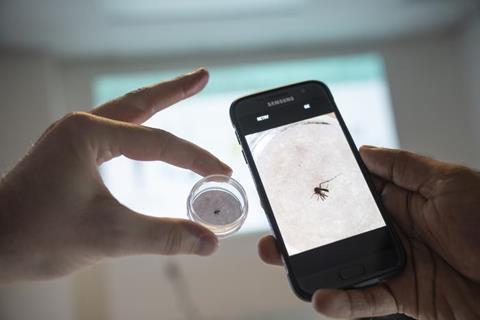Researchers from the University of South Florida have used artificial intelligence and citizen science to identify what may be the first specimen of Anopheles stephensi — an invasive and deadly malaria-carrying mosquito — ever detected in Madagascar. The study, led by USF scientists Ryan Carney and Sriram Chellappan, demonstrates how AI-powered image recognition and public participation can transform global disease surveillance.

Published in Insects, the discovery highlights how the combination of mobile technology and machine learning can fill critical surveillance gaps for vector-borne diseases.
READ MORE: Researchers turn to AI to help combat malaria in Africa
READ MORE: Faster and simpler point-of-care malaria test developed
Anopheles stephensi poses a growing threat across Africa because it thrives in urban environments, breeding in artificial containers such as tires and buckets rather than natural puddles like native Anopheles mosquitoes. Its spread could put an additional 126 million people at risk of malaria in Africa alone.
The breakthrough came from a single photo submitted by local residents in Antananarivo through NASA’s GLOBE Observer app. The image, showing a mosquito larva found in a tire, was later analyzed using AI algorithms trained on thousands of authenticated mosquito images. The system identified the larva as Anopheles stephensi with over 99% confidence. Supporting this classification, more than 100 other Anopheles larvae were discovered nearby in similar artificial containers the same day, though not photographed.
Doubling of cases
While official detection requires genetic testing — no longer possible because these specimens were immediately destroyed — if this species identification is correct, it would represent the first evidence of Anopheles stephensi in Madagascar. That same year, the country experienced a doubling of malaria cases and deaths.
Mosquitoes are the most dangerous animals on the planet, infecting over 700 million people each year with various pathogens. Malaria remains the deadliest, annually killing nearly half a million children under the age of five.
The implications of the research extend far beyond Africa, Carney and Chellappan said, as the need to be vigilant and proactive in the surveillance of malaria vectors is becoming increasingly important domestically. In 2023 the U.S. experienced local outbreaks of malaria for the first time in two decades. Florida had more cases than all other states combined, once again making the state ground zero for mosquito-borne diseases in the continental U.S.
Early warning data
Critically, the study shows that smartphone photos collected by citizens can serve as powerful early-warning data to help fight this rising threat.
“While mosquitoes can be thought of as tiny flying hypodermic needles, only 3% of species are known to transmit diseases to humans,” Carney said. “Thanks to citizen science apps, we can crowd-source photos of mosquitoes, and then analyze this imagery using AI, to scale up detection of those disease-spreading needles in the haystack.”
Early detection of the An. stephensi mosquito is crucial, but traditional surveillance methods often miss it. To address this, the researchers developed new AI tools that can identify mosquito larvae and adults from smartphone photos — similar to facial recognition technology. The larval algorithms were trained on thousands of authenticated images of Anopheles stephensi and other mosquito species.
AI-enabled smart trap
The study represents a successful example of cross-campus multidisciplinary collaboration, involving the USF Department of Integrative Biology; Bellini College of Artificial Intelligence, Cybersecurity and Computing; and College of Public Health. The research was supported by National Institutes of Health and National Science Foundation grants, and is a follow-up to the team’s previous study in Insects that won the journal’s 2022 Best Paper Award.
The researchers have now set their sights on developing and deploying hardware inspired by their software: an AI-enabled smart trap for remotely identifying Anopheles stephensi and other disease-spreading mosquitoes in Florida and beyond.
“AI is increasingly being used in many aspects of public health, and mosquito surveillance is an area of significant importance globally, and to Florida,” Chellappan said. “We believe we are pioneering next-generation surveillance systems for public health, geared towards combating mosquito-borne diseases.”







No comments yet